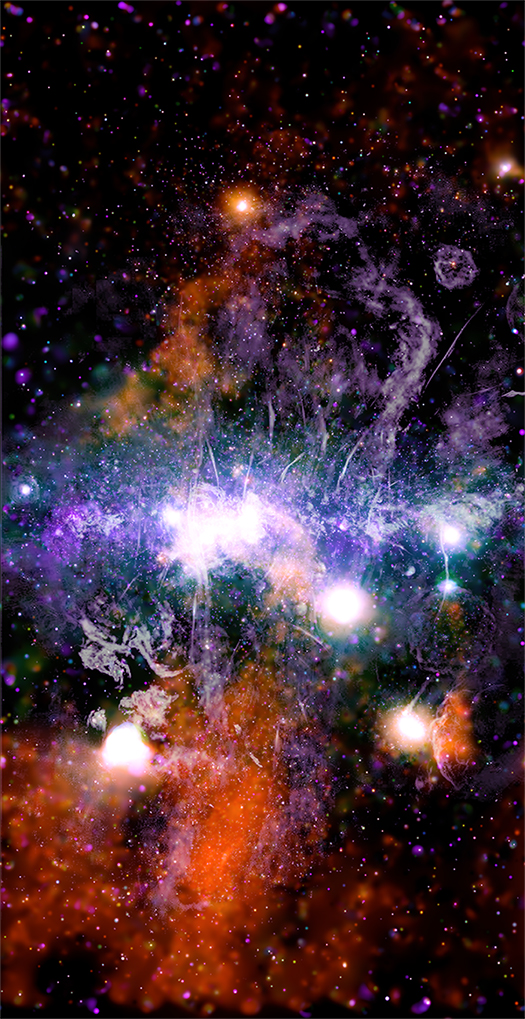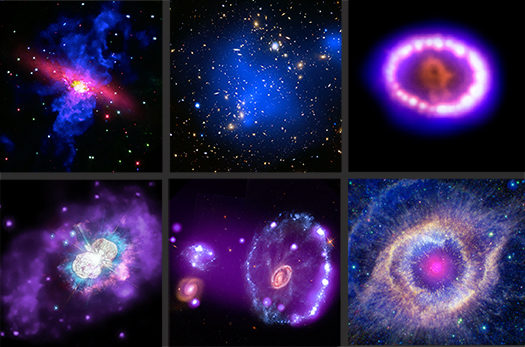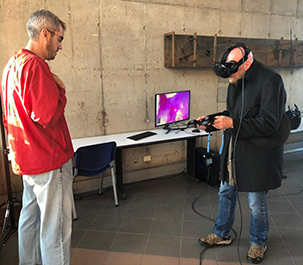Normal Galaxies & Starburst Galaxies
Powerful Yet Lonely: The Distant Quasar Left Alone in its Group
We are happy to welcome Valentina Missaglia as a guest blogger. She is the first author of the paper that is the subject of our latest press release. She is currently a postdoctoral researcher at the Institute of Astrophysics — FORTH in Heraklion (Crete) in the SMILE (“Search for Milli-LEnses”) group, recently funded by an ERC grant, that aims at investigating the nature of dark matter through observations of gravitational lenses on milli-arcsecond scales. Valentina earned her Ph.D. from the University of Turin (Italy) and her research focuses on radio and X-ray emission from radio-loud active galactic nuclei (which contain supermassive black holes that are rapidly pulling in material, producing intense radio waves) and how these sources interact with the surrounding medium. Before starting her Ph.D. in 2019, Valentina was a visiting student at the Center of Astrophysics | Harvard & Smithsonian, where she collaborated with Dr. Ralph Kraft on observations of galaxy clusters performed with NASA’s Chandra X-ray Observatory.
Looking at the night sky with the naked eye, we can only see an infinitesimal part of what the Universe contains, and the largest part cannot even be “seen”. Radio wavelengths have gifted us some of the most fascinating astronomical sources: radio-loud active galactic nuclei in the centers of galaxies, which can produce jets that extend way farther out from the optical galaxy itself.
The most powerful radio sources in the northern hemisphere are listed in a well- studied catalog, the Third Cambridge Catalog (3C), which contains the source we investigated with multiwavelength observations: 3C 297. This source appeared very intriguing in observations performed with Chandra in 2016. Therefore, we requested more time to better investigate features that we uncovered thanks to this first short observation, such as hot, X-ray emitting gas around our source.
Astronomers Dig Out Buried Black Holes With NASA's Chandra

SDSS J011522.18+001518.5 and SDSS J155627.74+241758.9
Credit: X-ray: NASA/CXC/SAO/D. Kim et al.; Optical/IR: Legacy Surveys/D. Lang (Perimeter Institute)
This panel of images represents a survey that used data from NASA’s Chandra X-ray Observatory to uncover hundreds of previously “hidden” black holes. This result helps astronomers conduct a more accurate census of supermassive black holes that exist in the centers of most large galaxies, as reported in our latest press release.
This graphic shows two of the galaxies from the new study, with Chandra X-ray data in purple and optical data from the Sloan Digital Sky Survey (SDSS) in red, green and blue. These black holes were found in galaxies that are dim in optical light, but bright in X-rays. Astronomers have dubbed these “XBONGs” (for X-ray bright, optically normal galaxies). While scientists have been aware of XBONGs for several decades, an explanation for their unusual properties has been unclear.
Exploring New Pathways for Massive Black Hole Formation with Chandra

Vivienne Baldassare
We are happy to welcome Vivienne Baldassare as our guest blogger. Vivienne is an Assistant Professor of Physics and Astronomy at Washington State University, and led the paper that is the subject of our latest press release. Her work is mainly focused on searching for the smallest supermassive black holes in order to learn more about black hole formation and growth. Prior to her current position, she was a NASA Einstein fellow at Yale University. She earned her PhD in Astronomy & Astrophysics from the University of Michigan in 2017, and a bachelor's degree in Physics from CUNY Hunter College in 2012.
One of the biggest open questions in astrophysics is “how do massive black holes form?” Our recent research with NASA’s Chandra X-ray Observatory provides support for the theory that massive black holes can form in what astronomers call nuclear star clusters.
While big galaxies have supermassive black holes at their centers, small galaxies often have a nuclear star cluster. Nuclear star clusters are extremely dense, with millions of stars packed into a region that is tens of light years across. It was once suggested that supermassive black holes and nuclear star clusters may be mutually exclusive, with the former residing in big galaxies and the latter occurring in small galaxies. However, some galaxies (like our Milky Way!) have been found to contain both. And excitingly, some theories suggest that nuclear star clusters might be able to form massive black holes.
In my first year of graduate school, I carried out a project studying the properties of nuclear star clusters. After that, I transitioned to studying massive black holes in dwarf galaxies, but have always had a soft spot for these fascinating objects. Our new study brought these two areas together.
From High School to a High-Energy Discovery

Julia Berndtsson
This blog post was written by Julia Berndtsson, a Swedish physics student currently in the third year of her undergraduate studies at Princeton University in the United States. For our latest Chandra result, she collaborated with Rosanne Di Stefano at the Center for Astrophysics | Harvard & Smithsonian during her last year of high school and through the first half of her freshman year at Princeton. She is currently exploring a range of topics in physics and engineering and works with Jason Petta's group at Princeton on developing semiconducting qubits.
When one imagines a scientist, a high school student usually isn’t the first thing that comes to mind. What people may or may not know is that there are multiple summer programs aimed at students still in their secondary education to gain exposure to research in their natural sciences, and it is because of such a program I ended up joining Dr. Rosanne Di Stefano in writing a paper on the discovery of the first planet candidate in an external galaxy.
The summer before my senior year, I was admitted to the Center for Excellence in Education’s Research Science Institute where participants were matched with a research mentor and given a project to be carried out over six weeks. Meeting Rosanne for the first time had me in awe. Not only did she give the students she took on her full confidence, but she would talk with excitement both about the topics that we were examining and over the fact that you were there to work on these problems too.
Behind the Story of the First Extragalactic Exoplanet Candidate

Rosanne DiStefano
We welcome Rosanne Di Stefano, an astrophysicist at the Center for Astrophysics | Harvard & Smithsonian, as our guest blogger. Her work has encompassed a broad range of astronomical systems: stars interacting within dense stellar environments, the binary evolution of possible progenitors of Type Ia supernovae, X-ray astronomy, and gravitational microlensing. In this post, she writes about her team’s finding of a possible planet candidate in M51, which is featured in our latest press release.
The discovery of a candidate planet in M51 (nicknamed the “Whirlpool” galaxy) represents several firsts. Perhaps most important, it is the first candidate planet in a distant galaxy. Since the 1750s, it has been conjectured that the dim distant nebulas, now called galaxies, are island universes: large, gravitationally-bound stellar populations similar to our home, the Milky Way. Since the work of Edwin Hubble in 1929, we have been able to study stars in other galaxies. Our discovery of the planet candidate — in a binary system called M51 ULS-1 — gives us the first peek into external populations of planetary systems, extending the reach of planet searches to distances roughly ten thousand times more distant.
The candidate planet is understood to be in the “circumbinary” orbit of a compact object (either a neutron star or a black hole) and a donor star, meaning that the donor and compact orbit one another and that the candidate planet orbits the mass center of these two. (We call it a “donor” star because the compact object is pulling material from its surface and into a disk around the neutron star or black hole.) This makes the planet candidate in M51 ULS-1 the first found to be orbiting a high-mass star. In our own Galaxy, astronomers have discovered more than 4800 planets, but the stars they orbit are less massive than about four times the mass of our own Sun. Stars can be very much more massive, however. While the exact value of the largest possible stellar mass in today’s Universe remains uncertain, it is at least 100 solar masses. The donor star in M51 ULS-1 appears to have the luminosity and spectrum of a 20 to 30 solar mass star.
Magnetized Threads Weave Spectacular Galactic Tapestry

The Galactic Center of the Milky Way
Credit: X-ray: NASA/CXC/UMass/Q.D. Wang; Radio: NRF/SARAO/MeerKAT
Threads of superheated gas and magnetic fields are weaving a tapestry of energy at the center of the Milky Way galaxy. A new image of this new cosmic masterpiece was made using a giant mosaic of data from NASA's Chandra X-ray Observatory and the MeerKAT radio telescope in South Africa.
The new panorama of the Galactic Center builds on previous surveys from Chandra and other telescopes. This latest version expands Chandra's high-energy view farther above and below the plane of the Galaxy — that is, the disk where most of the Galaxy's stars reside — than previous imaging campaigns. In the image featured in our main graphic, X-rays from Chandra are orange, green, blue and purple, showing different X-ray energies, and the radio data from MeerKAT are shown in lilac and gray. The main features in the image are shown in a labeled version.
Data Sonification: Stellar, Galactic, and Black Hole
Your browser does not support the video tag.
This latest installment from our data sonification series features three diverse cosmic scenes. In each, astronomical data collected by NASA's Chandra X-ray Observatory and other telescopes are converted into sounds. Data sonification maps the data from these space-based telescopes into a form that users can hear instead of only see, embodying the data in a new form without changing the original content.
NASA's Chandra Opens Treasure Trove of Cosmic Delights

Chandra Archive Collection: A Montage of Light From Space
Credit: NASA/CXC/SAO, NASA/STScI, NASA/JPL-Caltech/SSC, ESO/NAOJ/NRAO, NRAO/AUI/NSF, NASA/CXC/SAO/PSU, and NASA/ESA
Humanity has "eyes" that can detect all different types of light through telescopes around the globe and a fleet of observatories in space. From radio waves to gamma rays, this "multiwavelength" approach to astronomy is crucial to getting a complete understanding of objects in space.
This compilation gives examples of images from different missions and telescopes being combined to better understand the science of the universe. Each of these images contains data from NASA's Chandra X-ray Observatory as well as other telescopes. Various types of objects are shown (galaxies, supernova remnants, stars, planetary nebulas), but together they demonstrate the possibilities when data from across the electromagnetic spectrum are assembled.
Traveling to Our Galactic Center Through Virtual Reality
"Galactic Center VR" is an astronomy outreach app available now from the Steam and Viveport virtual reality (VR) stores. What is in this VR experience, and how did it come about? Dr. Christopher Russell, Director of the VR Lab at the Instituto de Astrofísica, Pontificia Universidad Católica de Chile (PUC), tells us in this blog post.
"Galactic Center VR" (GCVR) transports you 26,000 light years away to the center of our Milky Way. This fully immersive VR experience lets you explore our NASA supercomputer simulations of the central three light years around Sagittarius A* (Sgr A*), our galaxy's supermassive black hole. While the black hole is the region's dominant feature, the visual appeal comes from the complex structure of colliding winds from 25 massive stars, much of which is heated by shocks — akin to sonic booms from supersonic aircraft — to be aglow in X-rays and therefore studied with NASA's Chandra X-ray Observatory.
X-Rays Help Prove Some Galaxies are True Relics of the Ancient Universe

Professor David Buote
We welcome Professor David Buote as our guest blogger. Buote was one of the first Chandra Postdoctoral Fellows and is now a Professor at the University of California at Irvine. He has studied X-rays from massive elliptical galaxies and galaxy clusters since the time he was a graduate student. His new work with Aaron Barth on the dark matter in a relic elliptical galaxy is the subject of our latest press release.
This year marks the 20th anniversary of the Chandra X-ray Observatory and a chance to celebrate its many and diverse accomplishments. A critical aspect of Chandra's impact on astrophysics is its synergies with observations of phenomena throughout the electromagnetic (EM) spectrum and through other channels like gravity waves and neutrinos. Our study highlights how studies of the X-ray emission of a rare type of galaxy complement and augment what has been learned from observations of the stellar light at longer wavelengths.
Galaxies are broadly divided into two types — disks and spheroids — with substantial overlap in their properties. The spheroids — or elliptical galaxies — are approximately round but range in shape as observed on the sky from nearly circular to elongated somewhat like an American football viewed from the side. Most of what we know about the stars in galaxies comes from observations of visible light photons with lots of help from observations in the nearby ultraviolet and infrared (IR) parts of the EM spectrum.


